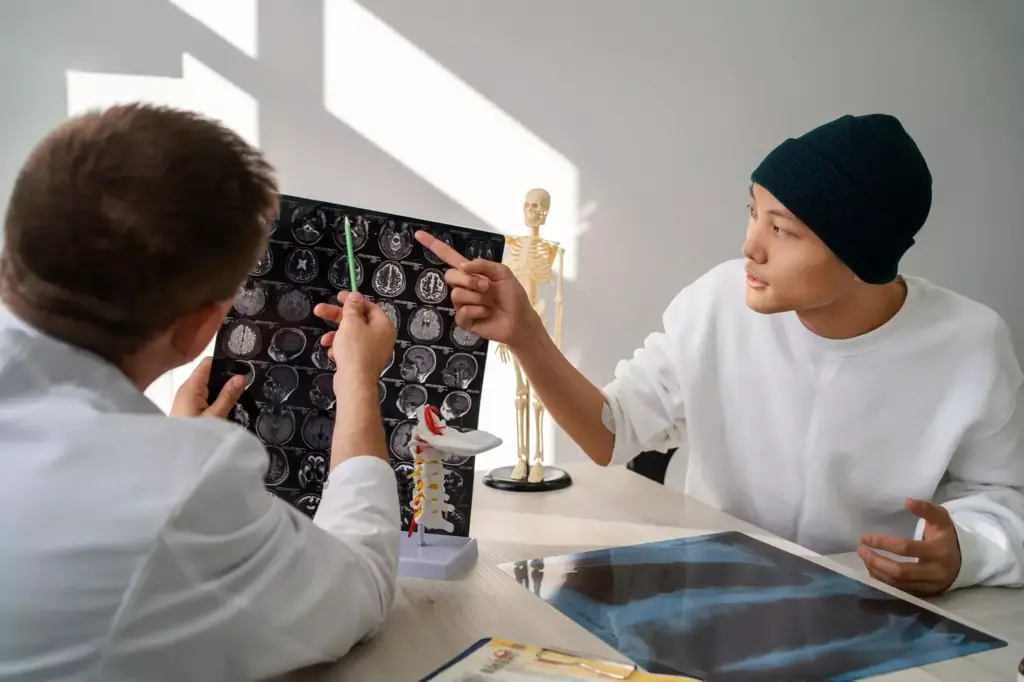Last Updated on November 26, 2025 by Bilal Hasdemir

It’s important to know about the different types of cancer. This knowledge helps in preventing, diagnosing, and treating cancer. At Liv Hospital, we focus on each patient’s needs. We follow international standards to give the best care for all cancer types.
There are more than 100 types of cancer, each with its own traits. These traits affect how we treat cancer and how well patients do. Studies show that things like being overweight and drinking too much alcohol can lead to certain cancer types. Our team works together to offer top-notch care that fits each patient’s unique situation.
Key Takeaways
- There are over 100 known types of cancer, each with distinct features.
- Understanding cancer classifications is vital for effective treatment.
- Liv Hospital provides patient-centered care, adhering to international best practices.
- Risk factors such as high BMI and alcohol consumption play a significant role in cancer development.
- Our team is committed to delivering comprehensive, personalized healthcare.
Understanding How Cancer Types Are Classified
Cancer comes in many forms, so we need a detailed way to sort them. This sorting is based on where the cancer starts and what it looks like. Knowing how to group different cancers is key for finding the right treatment.
The Cellular Origins of Cancer
Cancer types are mainly sorted by where they start. We have carcinomas, sarcomas, lymphomas, and leukemias. Carcinomas, for example, start in the skin or the lining of organs and glands.
- Carcinomas: These are the most common, starting in epithelial cells.
- Sarcomas: These start in connective tissues like bones and muscles.
- Lymphomas and Leukemias: These affect the immune system and blood.
Benign vs. Malignant Tumors
It’s also important to tell benign from malignant tumors. Benign tumors are not cancerous and don’t spread. On the other hand, malignant tumors are cancerous and can spread.
Knowing the difference helps doctors choose the right treatment. Benign tumors might just need watching or removal. But malignant tumors often need stronger treatments like surgery, chemo, and radiation.
By sorting cancer into types, doctors can find better ways to treat it. As we learn more about cancer, understanding these classifications is key to better care.
Major Classifications in the List of Cancers
Cancer is a complex disease with over 100 types. It can be divided into several main categories. Knowing these categories is key to diagnosing and treating cancer well.
Carcinomas: Epithelial Cell Cancers
Carcinomas are the most common cancer type. They start in epithelial cells, which line organs and glands. These cancers can happen in many places, like the skin, breast, lung, colon, and prostate.
Breast cancer often starts in the breast ducts or lobules. A leading oncologist says, “Carcinomas are a big part of cancer cases. Their classification helps decide the best treatment.”
“The way we classify carcinomas has changed oncology a lot,” said Dr. Jane Smith, a top cancer researcher.
Sarcomas: Connective Tissue Cancers
Sarcomas start in the body’s connective tissue. This includes bones, muscles, fat, and blood vessels. They are less common than carcinomas but can be tough to treat.
Soft tissue sarcomas happen in fat, blood vessels, and other tissues. They are a type of sarcoma.
Lymphomas and Leukemias: Blood and Lymphatic Cancers
Lymphomas and leukemias affect the blood and lymphatic system. Lymphomas start in lymph nodes and lymphoid tissues. Leukemias begin in the bone marrow and affect blood cells.
Hodgkin lymphoma and non-Hodgkin lymphoma are two main lymphoma types. They differ in their cells and treatment.
| Cancer Type | Origin | Common Subtypes |
|---|---|---|
| Carcinomas | Epithelial cells | Breast, lung, colon, prostate |
| Sarcomas | Connective tissue | Soft tissue, osteosarcoma |
| Lymphomas | Lymph nodes and lymphoid tissues | Hodgkin, non-Hodgkin |
| Leukemias | Bone marrow and blood cells | Acute myeloid, chronic lymphocytic |
Other Classifications: Germ Cell Tumors and Blastomas
Germ cell tumors and blastomas are rare in children and young adults. Germ cell tumors come from cells that make sperm or eggs. Blastomas come from immature tissues.
Examples include germ cell tumors of the ovary or testis and neuroblastoma, a blastoma affecting the nervous system.
Understanding cancer’s many types is key to better treatments and patient care. By classifying cancers, doctors can diagnose and manage them better. This improves life quality for those with cancer.
Most Common Cancer Types and Their Features
Certain cancers like breast, prostate, lung, and colorectal are big health worries. We’ll look at these cancers, their traits, and how they impact people.
Breast Cancer: Types and Characteristics
Breast cancer is a big worry for women worldwide. It starts in the breast and has different types based on the tumor’s location and traits. The most common type is invasive ductal carcinoma, which starts in the milk ducts and grows into the surrounding tissue.
Other types include invasive lobular carcinoma, which starts in the lobules (milk-producing glands), and inflammatory breast cancer, a rare but aggressive form. Knowing these types helps doctors choose the best treatment.
Prostate Cancer: Key Features
Prostate cancer mainly affects older men. It grows in the prostate gland, part of the male reproductive system. The risk factors include age, family history, and ethnicity. Because early-stage prostate cancer often has no symptoms, screening is key for catching it early.
The main types of prostate cancer include adenocarcinoma, the most common, and other rare types like small cell carcinoma and neuroendocrine tumors. Treatment depends on the cancer’s stage and how aggressive it is.
Lung Cancer: Major Subtypes
Lung cancer is a top cause of cancer deaths worldwide. It’s mainly split into two types: non-small cell lung cancer (NSCLC) and small cell lung cancer (SCLC). NSCLC is more common and includes subtypes like adenocarcinoma and squamous cell carcinoma.
SCLC is more aggressive and linked to smoking. Knowing the type is key for picking the right treatment, which can include surgery, chemotherapy, and targeted therapy.
Colorectal Cancer: Development and Progression
Colorectal cancer affects the colon or rectum and is linked to lifestyle and genetics. It often starts as a polyp, which can turn cancerous over time. Early detection through screening is vital for effective treatment.
The main types are colon cancer and rectal cancer, with most being adenocarcinomas. Treatment includes surgery, chemotherapy, and sometimes radiation therapy, based on the cancer’s stage and location.
Comprehensive List of Cancers by Organ System
Cancer is classified by organ system to better understand its many forms. This method groups cancer types by specific body parts. It helps us see the disease’s wide range.
Digestive System Cancers
Digestive system cancers are very common. They include:
- Esophageal Cancer: Affects the esophagus, often linked to chronic GERD.
- Gastric Cancer: Starts in the stomach lining. Risk factors include Helicobacter pylori infection and diet.
- Colorectal Cancer: Affects the colon or rectum. It often starts as benign polyps that turn malignant.
- Pancreatic Cancer: Occurs in the pancreas. It has a poor prognosis due to late diagnosis.
- Liver Cancer: Can be primary (hepatocellular carcinoma) or metastatic. It’s often linked to hepatitis B and C infections.
Respiratory System Cancers
Respiratory system cancers mainly include:
- Lung Cancer: The leading cause of cancer deaths worldwide. It’s often linked to smoking.
- Mesothelioma: A rare cancer affecting the lining of the lungs (pleura) or abdomen (peritoneum). It’s caused by asbestos exposure.
Reproductive System Cancers
Reproductive system cancers vary by gender:
- Breast Cancer: Can occur in both men and women. It’s more common in women.
- Prostate Cancer: Affects men. It’s often slow-growing but can be aggressive in some cases.
- Cervical Cancer: Primarily caused by HPV infection in women.
- Ovarian Cancer: Arises in the ovaries. It’s often diagnosed late due to nonspecific symptoms.
- Testicular Cancer: Affects men. It’s typically found in younger age groups.
Urinary System and Endocrine Cancers
Urinary system and endocrine gland cancers include:
- Kidney Cancer: Can arise from the renal parenchyma (renal cell carcinoma) or the renal pelvis.
- Bladder Cancer: Often linked to smoking and exposure to certain chemicals.
- Thyroid Cancer: Affects the thyroid gland. It has various subtypes, including papillary, follicular, and medullary thyroid cancer.
- Adrenal Cancer: Rare tumors that can be benign or malignant. They affect the adrenal glands.
Understanding these categories and the specific cancers within them helps patients and healthcare providers navigate the complex landscape of cancer diagnosis and treatment. By recognizing the organ system involved, we can better tailor our approach to managing the disease.
Cancers Starting with Specific Letters
Exploring oncology shows us a wide range of diseases. By organizing cancers alphabetically, we can focus on specific types. This helps us understand their unique traits and how to treat them.
Cancers Starting with ‘L’: Liver, Lung, Lymphoma, and Leukemia
Cancers starting with ‘L’ affect different parts of the body. Liver cancer can be primary or metastatic. Lung cancer is very common and often linked to smoking.
Lymphoma is a cancer of the immune system’s lymphatic system. It has two main types: Hodgkin and non-Hodgkin. Leukemia affects the blood and bone marrow, causing abnormal white blood cells.
- Liver Cancer: Linked to hepatitis B and C, alcohol abuse, and aflatoxin exposure.
- Lung Cancer: Mainly caused by smoking, but also by environmental factors and genetics.
- Lymphoma: Can occur anywhere in the lymphatic system, with symptoms depending on location and type.
- Leukemia: Characterized by too many abnormal white blood cells, acute or chronic.
Cancers Starting with ‘P’: Pancreatic, Prostate, and Other P-Cancers
Cancers starting with ‘P’ include diseases with unique features and treatments. Pancreatic cancer is often diagnosed late, making it hard to treat. Prostate cancer is common in older men.
Other ‘P’ cancers include penile and pituitary tumors. Knowing about these cancers helps us understand their risks, symptoms, and treatments.
“The diagnosis and treatment of pancreatic cancer remain challenging due to its late presentation and aggressive nature.” –
- Pancreatic Cancer: Symptoms are often nonspecific, leading to late diagnosis and poor prognosis.
- Prostate Cancer: Early detection through PSA testing has improved treatment outcomes.
Rare Cancer Types and Their Unique Characteristics
While common cancers get a lot of attention, rare ones are just as challenging. They affect many people worldwide, even though they are not as well-known. It’s important to understand these cancers to diagnose and treat them properly.
Rare Carcinomas
Rare carcinomas include tumors in the adrenal and thymic glands. Adrenal carcinomas start in the adrenal glands. These glands make hormones that control our body’s functions.
Adrenal carcinomas can grow fast and might not be caught until they’re big. Doctors usually treat them with surgery and sometimes medicine to manage hormone levels.
Uncommon Sarcomas
Sarcomas are cancers in the body’s connective tissues, like bones and muscles. Uncommon types include epithelioid, synovial, and angiosarcomas. Epithelioid sarcoma is a rare type that looks like a firm, painless lump under the skin.
Synovial sarcoma happens near joints in the arm, neck, or leg, mostly in young adults. It’s treated with surgery, radiation, and chemotherapy.
Rare Blood Cancers
Rare blood cancers include hairy cell leukemia and Waldenstrom macroglobulinemia. Hairy cell leukemia is a slow-growing cancer that makes too many B cells. This can cause anemia, infections, and other problems.
Waldenstrom macroglobulinemia affects B cells, leading to too much of a specific protein. Symptoms include tiredness, weakness, and neurological issues.
Other Rare Cancer Types
Other rare cancers include neuroendocrine tumors and mesothelial cancers. Neuroendocrine tumors come from endocrine cells and can be in different parts of the body, like the pancreas and thyroid.
“The diversity of rare cancers necessitates a personalized approach to diagnosis and treatment.” – Expert Oncologist
Mesothelial cancers, like mesothelioma, affect the lining of internal organs. They are linked to asbestos exposure.
Diagnosis and Treatment Approaches for Different Cancer Types
Cancer is complex and needs a variety of approaches for diagnosis and treatment. Each cancer type is different. This means a single treatment plan doesn’t work for everyone.
Diagnostic Methods Based on Cancer Type
Each cancer type needs its own diagnostic methods. For example, breast cancer is often diagnosed with mammograms and biopsies. On the other hand, lung cancer might use CT scans and PET scans. The right tool depends on the cancer’s location, size, and type.
| Cancer Type | Common Diagnostic Methods |
|---|---|
| Breast Cancer | Mammography, Biopsy |
| Lung Cancer | CT scans, PET scans |
| Colorectal Cancer | Colonoscopy, Sigmoidoscopy |
How Cancer Cell Types Influence Treatment Selection
The type of cancer cell is key in choosing treatment. For instance, carcinomas, which start in epithelial cells, might need surgery or targeted therapy. On the other hand, leukemias, which affect the blood, often require chemotherapy or bone marrow transplants.
Personalized Medicine in Cancer Treatment
Personalized medicine has changed cancer treatment. It tailors therapy to a patient’s genetic makeup and cancer specifics. This makes treatment more effective and reduces side effects. For example, patients with HER2-positive breast cancer can get targeted therapies like trastuzumab.
Understanding each patient’s cancer helps doctors create personalized plans. These plans can lead to better outcomes and a better quality of life.
Recent Advances in Cancer Type Identification
We are seeing big changes in how we diagnose cancer. New ways to classify cancer are helping us understand it better. This means we can treat it more precisely.
Molecular techniques are key in figuring out the different types of cancer. They help us see the complexities of cancer.
Molecular Classification of Cancers
By looking at the genes and molecules in tumors, we can understand how they work. This has led to finding new subtypes of cancer. Some genetic changes can really affect how well a cancer can be treated.
Molecular classification techniques include:
- Next-generation sequencing (NGS)
- Gene expression profiling
- Mutational analysis
These methods help us diagnose and treat cancer better. For example, NGS lets us quickly look at lots of genetic data. This helps find new ways to treat cancer.
Emerging Cancer Types and Subtypes
As we learn more about cancer, we find new types and subtypes. These have unique features that affect how they behave and how they should be treated. It’s important to recognize these to improve treatment and patient outcomes.
| Cancer Type | Molecular Characteristics | Clinical Implications |
|---|---|---|
| Breast Cancer | ER/PR positive, HER2 negative | Hormone therapy effective |
| Lung Cancer | EGFR mutation positive | Targeted therapy with EGFR inhibitors |
| Colorectal Cancer | KRAS mutation negative | Potential response to anti-EGFR therapy |
Knowing about these new cancer types and subtypes helps us tailor treatments. This leads to better results for patients.
Conclusion: Understanding the Diversity of Cancer for Better Outcomes
It’s key to understand the different types of cancer to improve treatment results. Knowing the unique traits of each cancer helps both patients and doctors make better choices. At Liv Hospital, we aim to give top-notch care to patients from around the world. We focus on giving detailed and caring care to help patients do better.
Cancer is complex, so we need a detailed plan to treat it. By knowing where each cancer comes from, we can create treatments that fit each patient’s needs. This tailored approach is vital for better care and a better life for patients.
As we learn more about cancer’s variety, we can make treatments that really work for each person. Our goal is to offer complete and caring care. We’re all about helping patients get the best results possible.
FAQ
What are the main classifications of cancer?
Cancer is divided into main types like carcinomas, sarcomas, lymphomas, and leukemias. There are also rare types like germ cell tumors and blastomas. Knowing these types helps doctors choose the right treatment and predict how well a patient will do.
How many kinds of cancer are there?
There are over 100 types of cancer, each with its own traits. We group cancers by where they start in the body. This helps us understand and treat them better.
What are the most common types of cancer?
The most common cancers are breast, prostate, lung, and colorectal cancer. Each has its own subtypes and needs. Knowing this helps catch cancer early and treat it effectively.
How are cancers categorized by organ system?
Cancers are grouped by the body system they affect. For example, there are cancers of the digestive, respiratory, reproductive, and urinary systems. There are also endocrine cancers.
What are some rare cancer types?
Rare cancers include adrenal and thymic carcinomas, and sarcomas like epithelioid and synovial. There’s also hairy cell leukemia and Waldenstrom macroglobulinemia. Knowing about these rare cancers is key for accurate diagnosis and treatment.
How do different cancer types affect treatment selection?
The type of cancer cell affects how it’s treated. Different cancers need different tests and treatments. Personalized medicine is important, tailoring treatment to each patient’s needs.
What are the recent advances in cancer type identification?
New ways to identify cancer include molecular classification. This uses molecular techniques to classify cancers more accurately. It helps find new subtypes, leading to better care.
What is the importance of understanding the diversity of cancer types?
Knowing about different cancers is key to better care. It helps patients and doctors make informed decisions. This leads to better diagnosis, treatment, and care.
How are cancers starting with the letter ‘L’ and ‘P’ classified?
‘L’ cancers include liver, lung, lymphoma, and leukemia. ‘P’ cancers include pancreatic and prostate cancer. Each has its own treatment approach.
What is the role of Liv Hospital in cancer treatment?
Liv Hospital offers top-notch care for international patients. Our team works together to provide detailed and caring cancer treatment. We aim for the best outcomes for our patients.
References
- National Cancer Institute. (n.d.). Cancer types. Retrieved from https://www.cancer.gov/types
- Wikipedia. (n.d.). List of cancer types. Retrieved from https://en.wikipedia.org/wiki/List_of_cancer_types
- MD Anderson Cancer Center. (n.d.). Cancer types. Retrieved from https://www.mdanderson.org/patients-family/diagnosis-treatment/cancer-types.html MD Anderson Cancer Center
- ICR Partnership. (n.d.). Cancer type list. Retrieved from https://www.icrpartnership.org/cancer-type-list
- Cancer Research Institute. (n.d.). Exploring the different types of cancer and treatment options. Retrieved from https://www.cancerresearch.org/blog/exploring-the-different-types-of-cancer-and-treatment-options








